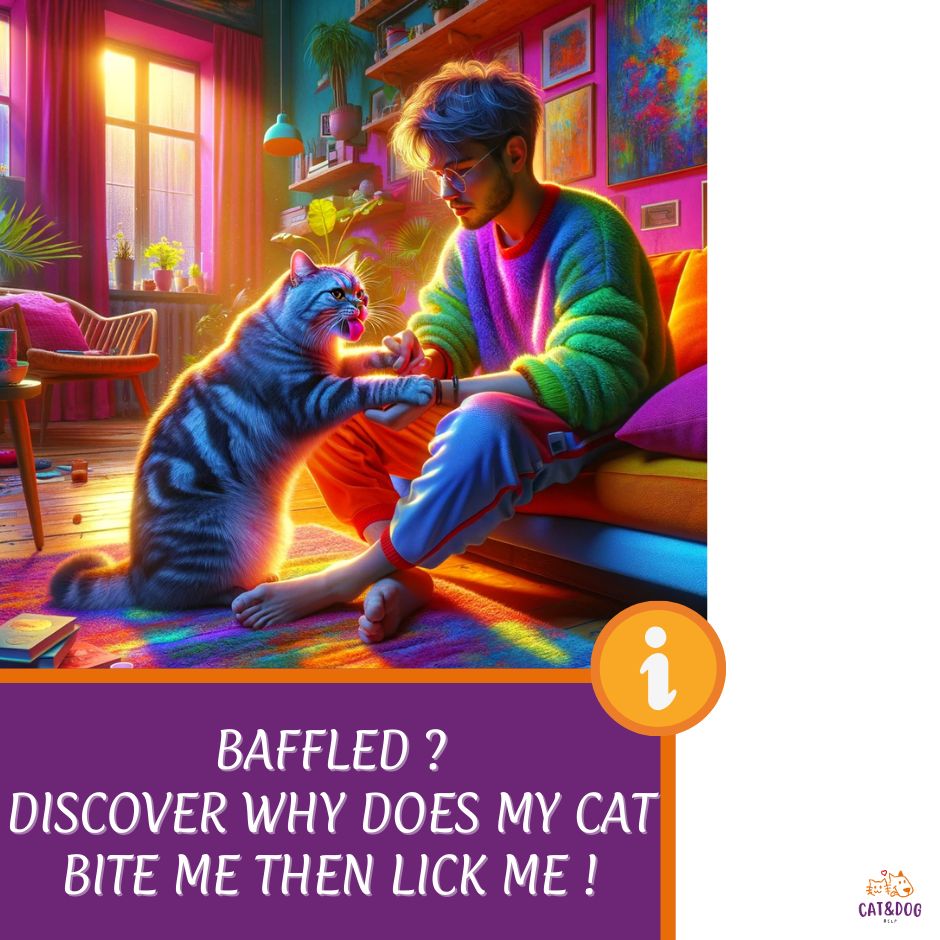Imagine you’re lounging on the sofa with your cat after a long day, enjoying the quiet moments, when suddenly—you feel a nip on your hand followed by a soothing lick.
At first glance, it may seem like mixed signals, but your feline friend might just be speaking in their language.
You’re not alone if you find yourself pondering, “Why does my cat bite me and then lick me?” Cats around the world exhibit this behavior, but what’s the story behind this curious gesture?
The bite followed by a lick from your cat is more than a quirky habit; it’s a way for them to communicate and show affection, a sign of affection, based on natural behaviors. (1)
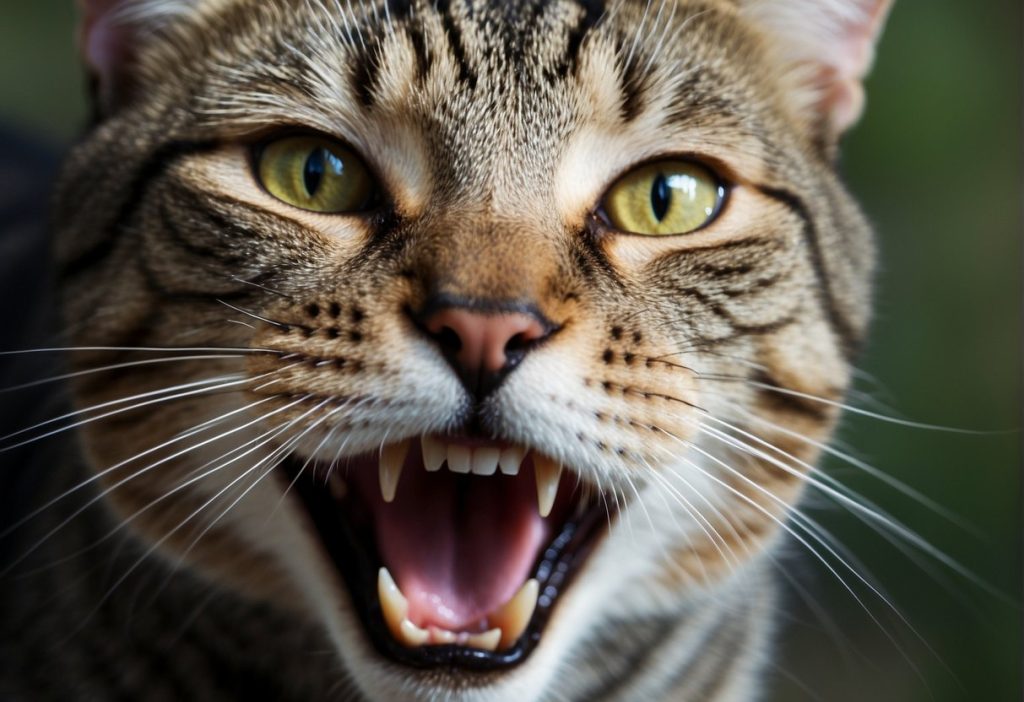
This peculiar tandem of actions is a blend of feline grooming rituals, playfulness, and sensory feedback.
Unveiling the reasons behind this enigmatic behavior allows us to deepen our understanding of our cats, enriching the bond between pet and pet parents.
So, let’s dive into the feline psyche and unravel the mystery of those love bites and licks.
Key Takeaways
- A cat’s bite followed by a lick is a form of communication and affection.
- This behavior is rooted in instincts and feline social habits.
- Understanding your cat’s signals can strengthen your bond with them.
Understanding Why Does My Cat Bite Me Then Lick Me
Your whiskered friend is using non-verbal cues to say a whole lot.
Studies suggest a whopping 90% of feline communication is through body language!
Cats are complex creatures with emotions that can turn a loving moment into a playful bite.
Dr. John Bradshaw, a cat behavior expert, enlightens us that these nibbles can be signs of affection, termed “love bites,” or may signal it’s time to stop the petting session.
Imagine a case study showing a cat in various emotional states: purring contentedly might follow gentle licks, whereas dilated pupils could mean a bite is a way of saying “enough is enough.” (2)
This behavioral spectrum emphasizes the importance of context when interpreting the ambiguous lick-and-bite combo.
To get a grasp on these mixed signals, let’s break it down:
- Affectionate Gestures:
A soft lick can simply be your cat’s way of showing love, with a soft bite underscoring their playfulness. - Overstimulation:
Repeated petting may lead to sensory overload—cue the biting as a polite ‘please stop.’ - Attention-Seeking:
Your attention might be the prize after a quick nibble, especially if it’s accompanied by an expectant gaze. - Communication:
Bites can be a form of expression, asserting a kitty’s needs or desires.
Learn to read the signs and keep the communication lines open – they’re talking volumes with their paws and jaws!
The Science Behind the Affection
Beyond Anecdotes: What Experts Say
Veterinarian insights and animal behavior studies shed light on this feline conduct.
For instance, Dr. Karen Becker and other experts suggest that these nips are your cat’s quirky love language—a kitty kiss, so to speak.
Curious about how to speak “cat”? A little bit of “tail talk” can go a long way. When your cat’s tail is upright and twitching, they’re likely feeling playful.
A low, slow swish? Watch out, they might be annoyed.
As for eye contact, a slow blink from your feline could be a signal of trust and affection, but if your cat consistently displays aggressive behavior, it may be worth consulting with a veterinarian for advice on supplements or medications to help manage their anxiety.
Common and Less Known Reasons for Biting Then Licking
- Playtime Antics:
Young cats often practice their hunting skills using their mouth and paws. - Grooming Gesture:
A quick nibble can also mean they’re grooming you, as they would with their feline kin. - Affectionate Action:
Those love bites can be misleading but endearing—your cat’s odd way of showing they care. - Sensory Overload:
Sometimes, a belly rub can be too much of a good thing, leading to an overstimulated bite. - Stress Signal:
Biting followed by licking could also signify your cat is feeling anxious or stressed.
Remember, each cat has its unique disposition, and learning their quirks is all part of the fun—and the mystery—of sharing life with them.
Keep an eye on the context and your cat’s full range of body language to crack the code of their affections.
Interpreting and Responding to Your Cat’s Signals

Bite then Lick – What Does It Mean?
- Playfulness:
Cats sometimes bite gently as a part of their play routine, then lick you as a make-up gesture. If this happens:
- Redirect their energy with toys.
- Engage in regular playtime to prevent boredom.
- Redirect their energy with toys.
- Affection:
Believe it or not, a nibble can be a sign of love, akin to a kitty kiss, but they can get carried away.
- Offer a calm stroke in return.
- Recognize and appreciate their affection.
- Offer a calm stroke in return.
- Overstimulation:
Your cat’s licking can turn into a nip when they’ve had enough petting.
- Respect their space and pause the petting.
- Watch for tail flicks or shifting postures that indicate they’re done.
- Respect their space and pause the petting.
- Stress or Fear:
Stress can lead to biting as a defensive act, with a lick as an apology or self-soothing action.
- Identify and remove stress triggers.
- Create a safe, quiet space for your cat to retreat.
- Identify and remove stress triggers.
Quick Tips for Reading Cat Body Language
- Eyes: Dilated pupils can signal excitement or stress.
- Ears: If they’re flattened or twitching, your cat might be irritated or scared.
- Tail: A swishing tail can mean they’re in a playful mood, but lashing could mean back off.
From General Care to Specific Behaviors
Understanding your cat’s bite-lick combo goes hand-in-hand with overall care. Here’s what you can do to keep these behaviors positive:
- Interactive toys: Provide plenty to prevent boredom.
- Climbing spaces: Offer vertical spaces for your cat to explore.
- Routine play: Schedule daily play to help use up that energy.
Balancing understanding with a stimulating environment should see those gentle bites and licks remaining part of the affectionate bandwidth between you and your furry companion.
Remember, it’s all about connection and communication, so keep those lines open, and you’ll both be purring in no time!
Practical Strategies for Managing Behavior
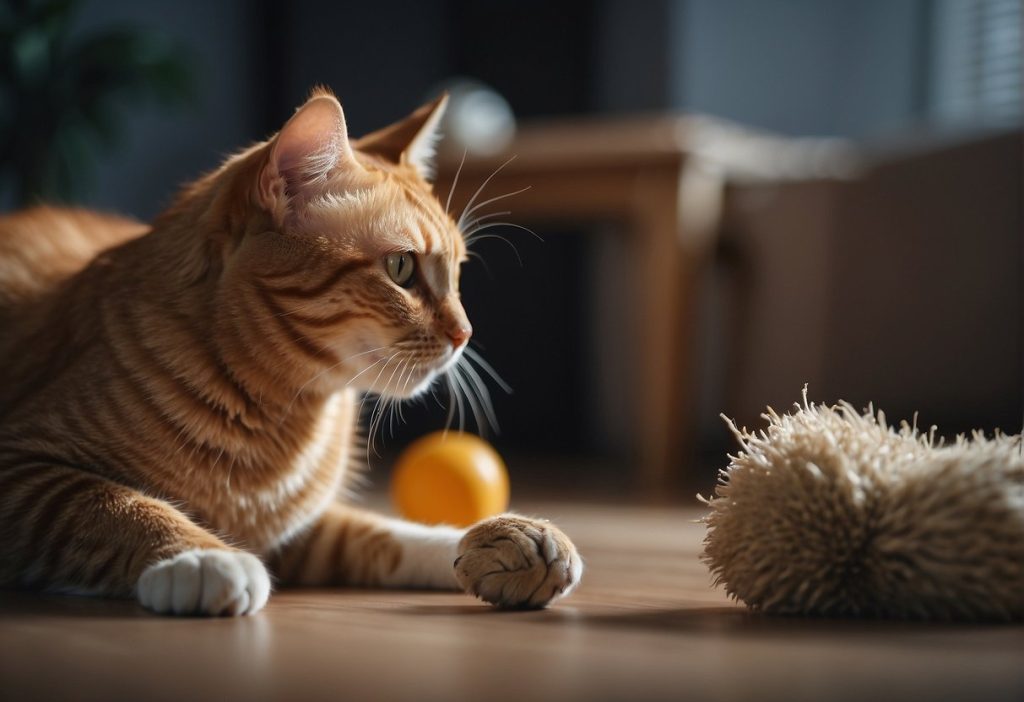
Positive Reinforcement Techniques Remember, your reaction to the love bite sets the stage for what happens next. Here’s how to encourage purr-fect manners: (3)
- Offer a treat or affection when your cat behaves nicely.
- Replace your hand with a toy if they’re in play-bite mode.
- Celebrate good behavior with a cheerful “Good kitty!” (Who doesn’t love a compliment?)
Clicker Training Tutorial Clicker training isn’t just for dogs. Cats are whip-smart and can learn a thing or two as well!
- Start by clicking the clicker and immediately give a treat.
- Repeat until your cat associates the sound with a yummy reward.
- When your cat licks without biting, click and treat! Make it rain catnip!
Understanding Deepens Connections Your bond grows stronger when you get why your cat might give love nips.
Here’s a quick list to keep the relationship sailing smoothly:
- Respond with a calm “no” and gently withdraw attention if they bite.
- Watch for signs they want to play and provide an appropriate outlet.
- Remember, they’re not plotting world domination—just communicating!
Success Stories Some folks have turned this biting biz around!
Like Sarah, who redirected her kitten’s bites to a feather wand, now they dance through playtime without a nip in sight.
Your cat’s quirky ways aren’t a mystery to solve—they’re an invitation to engage, learn, and grow together. After all, love is just a whisker away!
Advanced Insights into Cat Behavior
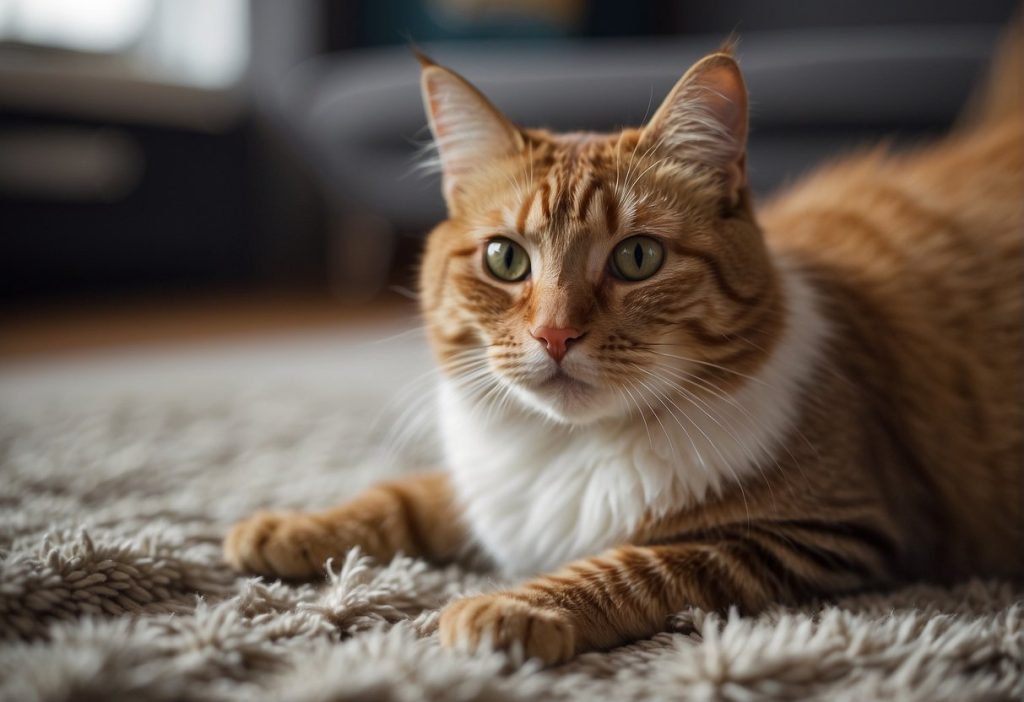
Let’s unravel some of those purr-plexing behaviors together!
Medical Muses:
Sometimes, your cat’s nibble-then-groom act could be a signpost to something deeper.
Medical conditions, from dental woes to discomfort, might be the culprit behind their mixed signals. If Tiger starts this behavior out of the blue, it’s wise to play detective with a vet. (4)
Bold actions for furry problems, I say. Here’s a tail, erm, tale for you:
- Case Study:
Miss Whiskers’s Mystery Mood Swings – Owners were baffled by her sudden bite-lick routine.
A vet check later, they discovered a hidden dental issue was causing her discomfort, leading to erratic actions. Post-treatment? Miss Whiskers became her cuddly self again.
Expert Echoes:
Vets universally chant the mantra of regular check-ups to keep such unexpected behavior at bay.
Understanding your cat’s health can help you decode their actions and ensure happy, pain-free purrs.
Now, resources – they’re like catnip for your brain. Here’s a handy list for when you want to dive deeper:
- “Understanding Your Cat’s Body Language” – A crash course in tail twitches and ear flicks.
- “Paws-and-Effect: Medical Conditions and Behavior” – Find out how health influences habits.
In essence, your whiskered companion speaks volumes through every quirk.
So, keep tabs, stay informed, and remember, that little chomp followed by a lick might just be their way of saying, “Hey, check this out!” Or, “You’re mine, buddy!”
Either way, stay observant, and keep the cuddle (and bite) sessions in check!
Quick Recap
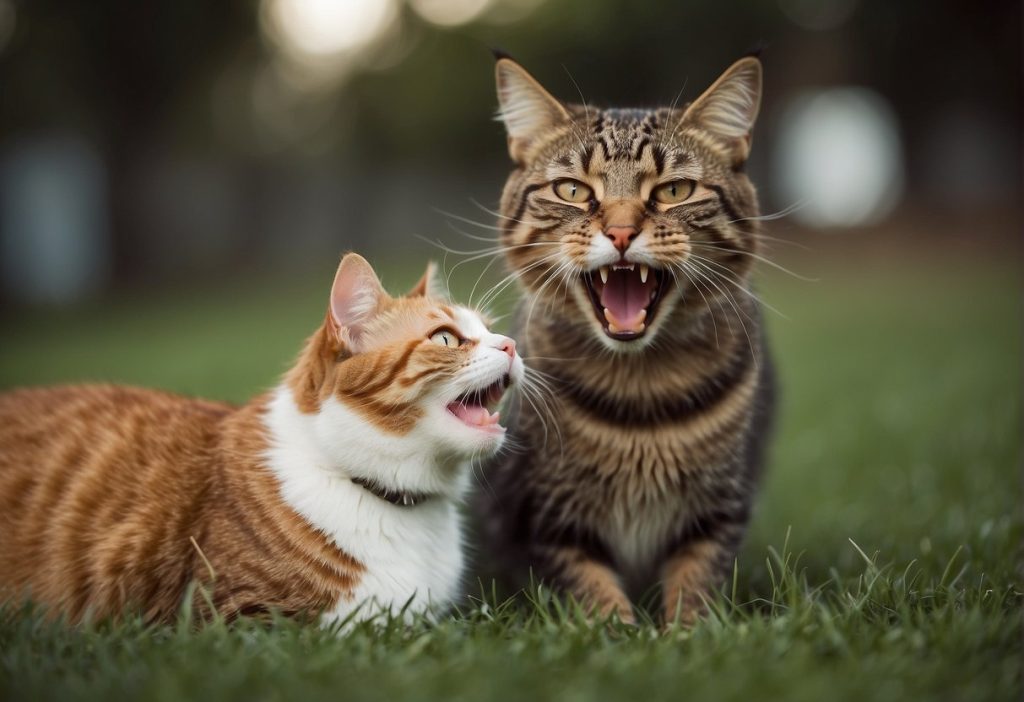
Love Bites or Play Aggression?
Your cat might gently bite followed by a lick as an adoration gesture, similar to how it grooms itself.
On the flip side, this might be your cue to engage in play. Remember, cats sometimes struggle to communicate, so they might mix playtime with a chomp.
- Affection: Think of it as their quirky way of showing love.
- Play: A nibble suggests, “Hey, let’s have some fun!”
- Communication: Biting during petting can be a sign they’ve had enough. (5)
Reading Your Cat’s Body Language
Keep an eye on their ears and tails. If their ears turn back or their tail swishes rapidly, that’s cat-speak for “I’m getting a bit irked here!”
Stress:
Cats under stress might over-groom or bite. If this is a regular occurrence, it’s a red flag to check in on your fur baby’s happiness levels.
Attention to Health
Sometimes, a bite-lick combo might flag health issues. Watch out for any unusual or compulsive behavior.
Had one of those “bite and lick” encounters lately? Share your stories! But if the biting seems off or excessive, let’s not bite around the bush – a quick chat with the vet wouldn’t hurt.
Your whiskered roommate could have something on their mind (or in their mouth).
Frequently Asked Questions
Let’s unravel the mystery behind your cat’s lick-then-bite greeting! This quirky behavior can leave you puzzled, but understanding it deepens the bond between you and your furry friend.
What does it mean when a cat bites then licks you?
When your cat bites then lick you, it often signifies affection. Known as ‘love bites,’ this behavior mimics the way cats interact with each other.
So, if you get a nibble followed by a lick, chances are your cat considers you part of their family.
Is biting then licking a sign of aggression in cats?
Not usually. While it might seem counterintuitive, biting and then licking isn’t typically a sign of aggression. It’s more about communication.
Your cat could be playfully indicating they want attention or they’re overstimulated and asking you to stop whatever you’re doing.
How can I stop my cat from biting me?
To reduce biting, pay attention to your cat’s body language. If they seem irritated or their tail starts to flick, give them space.
Encourage play with toys instead of hands to avoid accidental nips during playtime.
Could medical issues cause my cat to bite and then lick?
Yes, sometimes biting then licking could be attributed to medical issues, such as dental pain or discomfort.
If this behavior is new and accompanied by other changes in behavior or appetite, consult your vet.
How do I tell if my cat is stressed?
Signs of stress in cats include excessive grooming, changes in eating habits, and more vocalization than usual.
If your cat’s lick-bite routine is accompanied by these behaviors, stress might be the culprit.
What should I do if my cat’s biting hurts me?
If your cat bites hard enough to hurt you, say “ouch” firmly and withdraw your attention immediately.
This mimics the natural reactions of other cats and teaches your pet that biting isn’t acceptable.
Can I train my cat out of this behavior?
You can work on modifying this behavior by using positive reinforcement.
Reward your cat with treats and affection when they interact without biting and gently discourage biting when it occurs.
Be consistent, and over time your cat will learn.

